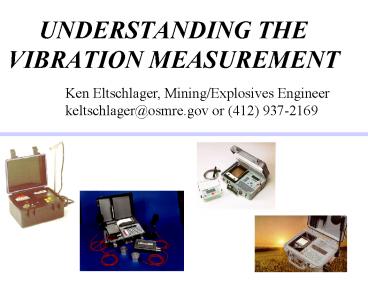UNDERSTANDING THE VIBRATION MEASUREMENT PowerPoint PPT Presentation
1 / 24
Title: UNDERSTANDING THE VIBRATION MEASUREMENT
1
UNDERSTANDING THE VIBRATION MEASUREMENT
Ken Eltschlager, Mining/Explosives
Engineer keltschlager_at_osmre.gov or (412) 937-2169
2
Confinement
3
Spatial Relationships
Complaint House 2, 1500
Complaint House, 550
Compliance House, 450
4
Vibration Energy
Home
Airblast 1,100 fps
Blast
Body Waves 20,000 fps
Surface Waves 5,000 fps
5
Time Histories or Waveforms
6
Frequency
- Number of cycles per second
- Measured in Hertz (Hz)
- f 1/T
- T is the time of one cycle
- Zero-crossing used by seismographs
- f 1 / (2t)
- t is the time of ½ a cycle or where the wave
crosses zero
7
Displacement or Amplitude
- The distance a particle moves (D)
- D measured in inches (in)
- Important for damage assessment
8
Velocity
- The rate or speed at which a particle moves
- V is in inches per second (in/s)
- For sine waves V 2 ? f D
- f is frequency, Hz
- ? is 3.14
- Important for compliance
9
Acceleration
- The rate at which a particle changes speed
- A is in inches per second squared (in/s2) or
gravities (g) - For sine waves, A 2 ? f V
- Important for coupling
10
Acceleration
- Acceleration in gs A 2 ? f V/386
- Where A Acceleration
- f frequency
- V velocity
- (To express acceleration in gs divide by 386)
11
Why Use Seismographs?
- Establish Compliance with Rules
- Evaluate Blast Performance
- Provide Liability Protection
12
(No Transcript)
13
Blasting Seismographs
- Measure ground velocity time histories
- Component directions
- Measure airblast time history
- Measured in pressure (psi)
- Converted to Decibles (dB)
- Provide Summary information
- Conduct internal operations check
14
(No Transcript)
15
Recordings are controlled by
- How the seismograph is made
- ISEE Performance Specifications for Blasting
Seismographs (2000) - How the seismograph is placed in the field
- ISEE Field Practice Guidelines for Blasting
Seismographs (1999) - For specifications on each, go to
http//www.isee.org/sections/blast.htm
16
(No Transcript)
17
(No Transcript)
18
(No Transcript)
19
Ground Vibrations
- Distance SD PPV
- lt 301 50 1.25
- 301 5000 55 1.00
- gt5001 65 0.75
- -----------------------------------------------
- Blasting Equations
20
Airblast
- 2 Hz microphone 133 dB
- All seismographs manufactured today have 2 Hz
lower frequency response range.
21
What are the Most ImportantParameters in
Evaluatingthe Adverse Effects?
- Location of the blast
- Location of the compliance house
- Distance between the two
- Charge weight per delay
- Confinement
- Type of blast
22
Flyrock
- Beyond the permit area
- Beyond the blast area
- gt ½ the distance to a house
23
(No Transcript)
24
OSM Resources
- Appalachian Region Blasting Web Page
- www.ARblast.osmre.gov
- Reports and Publications
- Technical Innovation and Professional Services
(TIPS) - www.tips.osmre.gov
- Blast Log Evaluation Program (BLEP)
- keltschlager_at_osmre.gov or (412) 937-2169

